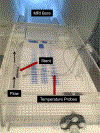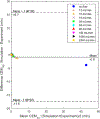Computational modeling of the thermal effects of flow on radio frequency-induced heating of peripheral vascular stents during MRI
- PMID: 37844574
- PMCID: PMC12305398
- DOI: 10.1088/2057-1976/ad0398
Computational modeling of the thermal effects of flow on radio frequency-induced heating of peripheral vascular stents during MRI
Abstract
Purpose. The goal of this study was to develop and validate a computational model that can accurately predict the influence of flow on the temperature rise near a peripheral vascular stent during magnetic resonance imaging (MRI).Methods. Computational modeling and simulation of radio frequency (RF) induced heating of a vascular stent during MRI at 3.0 T was developed and validated with flow phantom experiments. The maximum temperature rise of the stent was measured as a function of physiologically relevant flow rates.Results. A significant difference was not identified between the experiment and simulation (P > 0.05). The temperature rise of the stent during MRI was over 10 °C without flow, and was reduced by 5 °C with a flow rate of only 58 ml min-1, corresponding to a reduction of CEM43from 45 min to less than 1 min.Conclusion. The computer model developed in this study was validated with experimental measurements, and accurately predicted the influence of flow on the RF-induced temperature rise of a vascular stent during MRI. Furthermore, the results of this study demonstrate that relatively low flow rates significantly reduce the temperature rise of a stent and the surrounding medium during RF-induced heating under typical scanning power and physiologically relevant conditions.
Keywords: MRI; MRI safety; RF-induced heating; medical devices; stents.
Creative Commons Attribution license.
Figures







Similar articles
-
Impact of lateral movement of patients on radiofrequency-induced heating of active and passive implantable medical devices at 3T MRI.Magn Reson Med. 2025 Oct;94(4):1714-1730. doi: 10.1002/mrm.30578. Epub 2025 May 23. Magn Reson Med. 2025. PMID: 40407795
-
Predicting RF Heating of Conductive Leads During Magnetic Resonance Imaging at 1.5 T: A Machine Learning Approach.Annu Int Conf IEEE Eng Med Biol Soc. 2021 Nov;2021:4204-4208. doi: 10.1109/EMBC46164.2021.9630718. Annu Int Conf IEEE Eng Med Biol Soc. 2021. PMID: 34892151 Free PMC article.
-
Reduction of radiofrequency induced implant heating via flexible metasurface shielding at 7 T.J Magn Reson. 2025 Aug;377:107918. doi: 10.1016/j.jmr.2025.107918. Epub 2025 Jun 2. J Magn Reson. 2025. PMID: 40479878
-
Active body surface warming systems for preventing complications caused by inadvertent perioperative hypothermia in adults.Cochrane Database Syst Rev. 2016 Apr 21;4(4):CD009016. doi: 10.1002/14651858.CD009016.pub2. Cochrane Database Syst Rev. 2016. PMID: 27098439 Free PMC article.
-
Intravascular brachytherapy for peripheral vascular disease.Cochrane Database Syst Rev. 2014 Jan 8;2014(1):CD003504. doi: 10.1002/14651858.CD003504.pub2. Cochrane Database Syst Rev. 2014. PMID: 24399686 Free PMC article.
References
-
- Griebel Adam J., Anttila Eric, Baker Grant, Schaffer Jeremy E., Gross David C.; Magnetic Susceptibility of Common Metals and Alloys Used in Medical Devices. J. Test. Eval 1 November 2023; 51 (6): 4554–4566. 10.1520/JTE20220654 - DOI
Publication types
MeSH terms
Grants and funding
LinkOut - more resources
Full Text Sources
Miscellaneous
